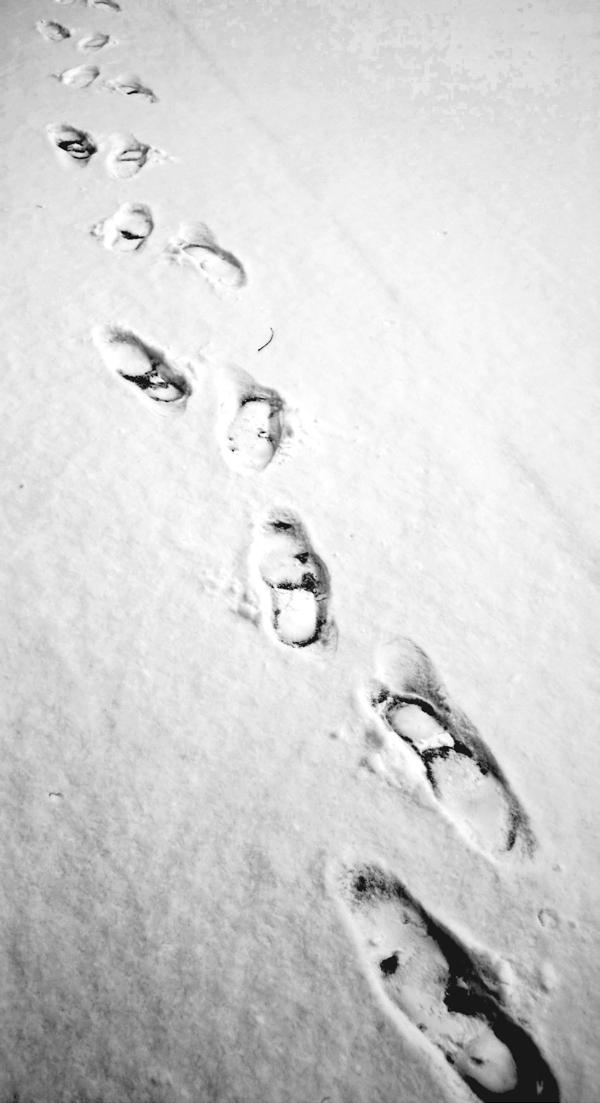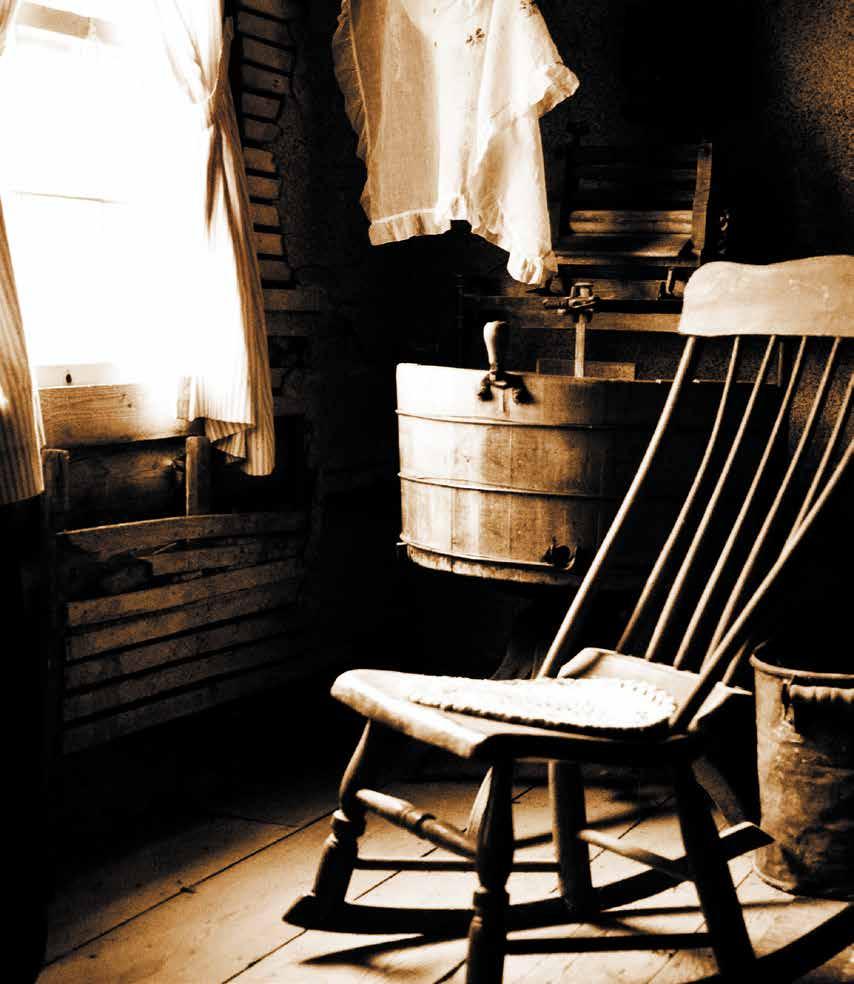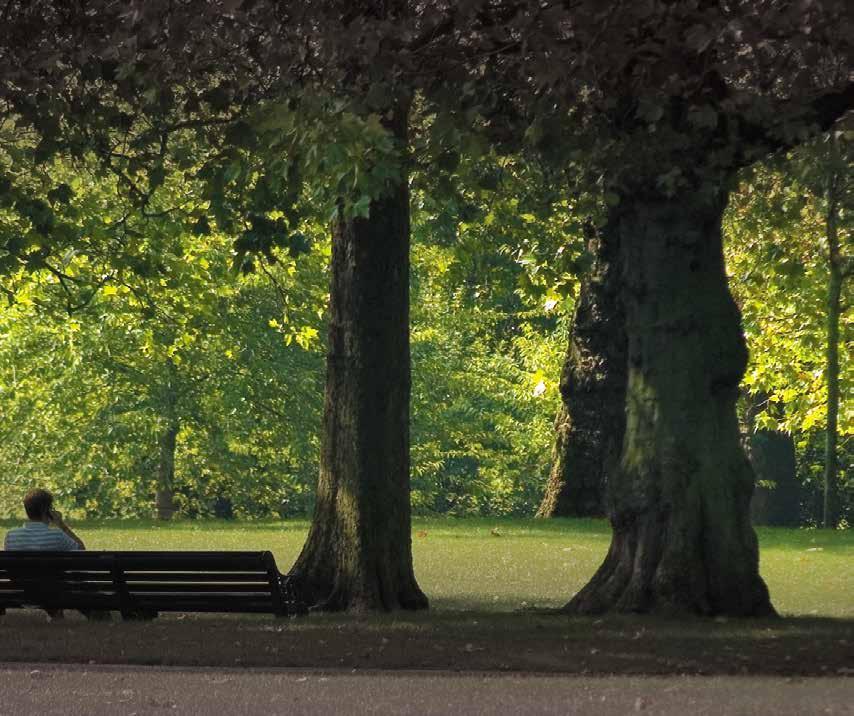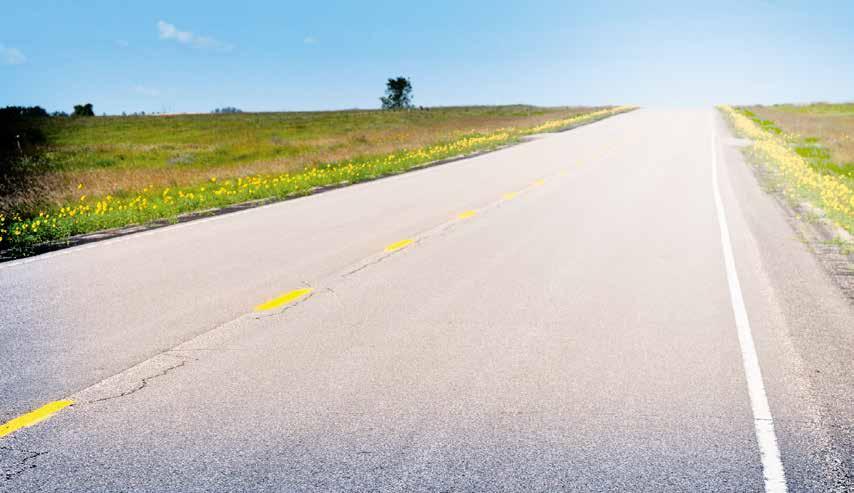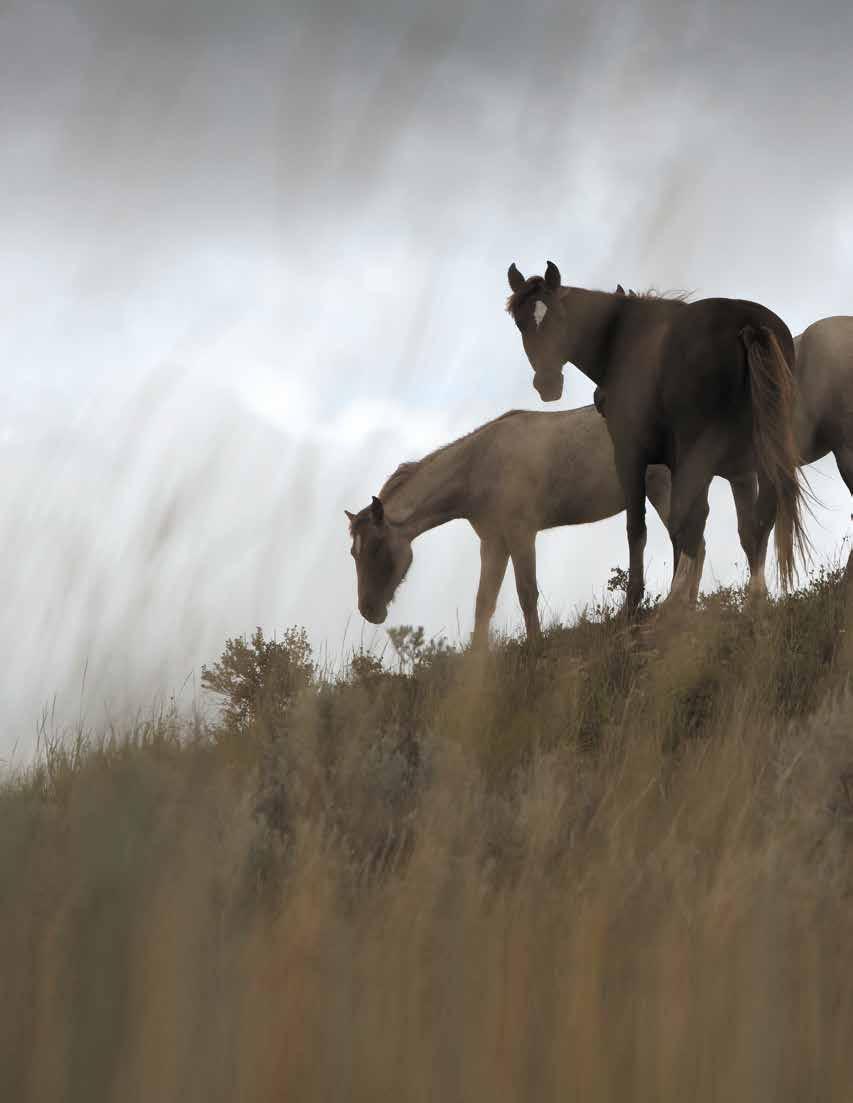
27 minute read
A Spiritual Odyssey on the Northern Plains
By Clay S. Jenkinson
I’m fascinated by the idea of “spirit of place” and have written a whole
Advertisement
book trying to define it and figure out if I have it, if we North Dakotans
have it. But for all of that I am not really sure what it is. It might be useful
to begin by differentiating two types of “spirit of place.”
Spirit of place is either something that emanates from the land and into the people who inhabit or visit it; or it is an attitude held by people towards a place. In other words, either the place permeates people with meaning or identity; or people invest a place with meaning because of their historical or personal association with it. When these two types of spirit of place come together, a very powerful sense of resonance occurs.
An example of a place on the Great Plains that has spirit of place is the Little Bighorn Battlefield National Monument on the plains of Montana. I know a dozen people who have visited the site over the years who swear there is something eerie going on there that cannot be explained rationally. They say they can “feel” something—the battle, the ghosts, an energy in the grass, a kind of karma. My mother (who is not given to the metaphysical) says there is a barely perceptible “sitz sitz sis sis sitz,” she literally hears when she is there, coming from the wind in the grass, and that this unaccountable sibilance means something. I know a disillusioned history professor who says that anyone who happens upon the site and walks around will inevitably “feel” something heightened there. I know a rational preacher who is skeptical of the Apostles Creed, but who was visibly moved by the spirit in the grass when he visited the battlefield for the first time. He had been reading about the battle for many years. “Words, words . . . words,” says Hamlet.
Now whether there is really any intrinsic spirit of place at the Little Bighorn battlefield or just meaning we have invested in it because of the amazing terrible thing that happened there on June 25, 1876, is an interesting question. My mother swears that anyone who ventured onto the ridge, someone looking for a K-Mart or a place to have a quiet picnic, but with no understanding of what transpired there 134 years ago, would experience some sort of soul’s heightening. Others, a little less certainly, are inclined to agree.
A more common example is a family’s home place. My family has one in Fergus Falls, Minnesota. My grandparents Dick and Rhoda Straus lived there for forty years. It was a small rolling hills farm of about 85 acres, a third of it pasture, and the rest cropland. They milked cows—just sixteen of them, each with a name like Bess or Whitey or Pal—and at times they raised chickens and pigs, and a half dozen steers for the meat market. We no longer own the farm. That’s a long story interesting only to us. But I make the pilgrimage to the home place at least once a year. When I am there I invariably go into the barn to kick around among the stalls. I can remember which stanchion belonged to which Holstein or Guernsey. I climb up into the hayloft and scramble around a little among what’s left of disintegrating hay bales. I always walk the whole perimeter of the farm. I make my annual check of Grandma’s rhubarb plants out along the lilac trees west of the house and as I sit in the grass next to Grandma’s big garden I loosen my grip on my mind so that the memories and associations can run free. I deplore, mostly on behalf of my mother, the way they (I have lost track of the tenants’ names) have “let the place go,” particularly the large brick flower planters that flank the front door. As I walk about on the warm earth of the old family farm, I feel sad and glad and recharged with memory. I feel closer to my roots. I ache for what has been lost: in my life, in my family, in the lifeway of the upper plains, in rural life, in America. And then I get in my car and drive away.
Spirit of place, then, is the value added of a site that cannot be measured in economic terms. It is related to the physical, but its significance is metaphysical— or perhaps the physical and metaphysical mated in a kind of irresistible minuet. Ask any person to describe the place most important of all the places on earth. For one, it is a beach on Santorini. For another, it is a coffee shop in Seattle. For a third, it is a calm bay at the base of a calving glacier in the panhandle of Alaska. For most, it is home, or the old home place.
Everyone is from somewhere. But what does that somewhere have to do with anything? We live at a time in human history when place matters less than it ever has before. Almost any American community with a population of more than 5000 has a Dairy Queen, a Pizza Hut, perhaps a Hardees. Any place with more than 25,000 people has an somewhere Applebee’s and a Wal-Mart. The American people are fond of national and international chain stores have to and restaurants. There is some sort of a population trigger effect that determines who has access to do with what plateau of amenities—in shopping, in dining, in lodging. Communities measure themselves—they use the term “quality of life”—by how high up the hierarchy of chain store placement they have risen.

Thanks to satellite and cable television, virtually every American watches the same television programs. The same sitcoms entertain folks on the Navaho Indian Reservation and Boston, Massachusetts. We drive the same cars and fill them at the same gas stations, which are laid out identically in San Diego, California, and Anchorage, Alaska. Almost all commercial buildings in America are climate controlled. Almost all cars are air-conditioned. People walk out of their homes not into nature but into their garages, depart by way of automatic garage door openers, drive to a paved and developed precinct (to shop, dine, work, recreate, or work out), then return home at the end of the excursion, close the garage door behind them, and enter their houses, where they spend the great majority of their discretionary time watching the homogenous television programming of America or sitting in front of a computer terminal.

Our lives are mediated and abstracted and deracinated as never before. In some sense it doesn’t really matter any longer whether you live in Minot, North Dakota, or Minden, Nevada; in Austin, Texas, or Alexandria, Virginia. Our experiences are essentially played out in fabricated arenas that could literally be anywhere—anywhere in America and to a certain extent anywhere on earth. If 100 years ago our great grandparents were so deeply rooted in place that their lives were constricted, constrained, confined, claustrophobic, and profoundly provincial, we, 100 years later, live in a manner that is almost entirely detached from place. Americans, de Tocqueville said, are the most restless people on earth. In the 21st century, even when we don’t migrate from place to place, we have added rootlessness to restlessness.
It could easily be said that, as the 21st century begins, we live in the geography of Nowhere. That which could be anywhere—Best Buy, Olive Garden, Sam’s Club—is also nowhere.
It would be interesting to know how much time per day, per week, and per year the average North Dakotan now spends outside. How many hours per year does a North Dakotan spend off pavement? And of the time spent outside, how much of it truly signifies North Dakota qua North Dakota, and not a fabricated and domesticated enclave of Kentucky bluegrass lawn that could just as easily encircle a house in Albuquerque, Connecticut, or Georgia? How many days per year do any of us spend in a manner that could be said to resonate with the land, the history, or the spirit of the Great Plains (as opposed to the land-history-spirit of North Carolina or the florescent geography of Nowhere)?
We all acknowledge the general way in which place shapes character, of course. Put someone who grew up in Mississippi and someone who grew up in New Hampshire on the same stage in Chicago and everyone will know the difference, at least the moment these representatives open their mouths and begin to talk. Both are Americans. Both drink soda, both order Dominos Pizza, both watch American Idol. They share lives as consumers. But (in descending order) they will almost certainly exhibit differences in accent, to a certain extent in diction, in the way they dress, in body language and style; and they are likely to have quite different political outlooks. Now pluck them out of the artificial environment of Chicago and put them back in their home states, back into their natural habitats, surrounded by their own folk, and their state and regional identities are likely to be more pronounced, at times much more pronounced. People regain their default accents and Tocqueville’s “habits of the heart” when they go home, and they are more comfortable there to express their full personality and identity without inhibition.
We all acknowledge that there is a Texas type, a California type, a Long Island type, a Minnesota type. But is there a North Dakota type?
If a North Dakotan moves to Philadelphia, Miami, or Detroit, does anyone say, “There is something about you. Are you by any chance from North Dakota?” Almost all of us are very clearly Americans. Many of us exhibit some sort of regional identity. It might be possible, from accent and idiosyncrasies of phraseology, for a stranger to “locate” a North Dakotan as Midwestern, to place the North Dakotan somewhere in the region between Wisconsin and Idaho, North Dakota and Kansas, but it would be quixotic to argue that the landscape and the social structure of North Dakota stamp a distinctive identity on the people who grow up here.
State identity is interesting, and it is worth reflecting on how difficult it is to distinguish North Dakotans from the inhabitants of a number of states of the same region; but it is much more interesting to explore the spirit of place that is available to North Dakotans, but not inevitable, the spirit of place that is not part of the automatic software that virtually every North Dakotan runs by virtue of growing up in this region of the country, but rather something that people have to make a conscious choice to embrace if they wish to understand it or exemplify it. In other words, spirit of place is a choice, a journey, and a quest, not merely a birthright.
I’m going to make an effort to define some of the elements of a North Dakota spirit of place, knowing that such a definition depends on the eye of the beholder. One of the principal truths of life is that the lens you wear determines what you see. If you wear the lens of economic development as you gaze at North Dakota, you see beneath the surface of the land to the coal, oil, and natural gas fields that beckon in the basement of the state. If you wear the lens of tourism, you see the Lewis and Clark trail, and Fort Mandan; Custer’s route first to the Black Hills (1874) and then his last journey to the Montana line and on to the Little Big Horn (1876); Theodore Roosevelt engaged in comic-hectic self-fashioning in the Dakota badlands; water skiing and sport fishing on Lake Sakakawea and Metigoshe. If you wear a Jeffersonian lens, you see family farms diffused across the landscape, coop grain elevators, virtuous democratic villages.
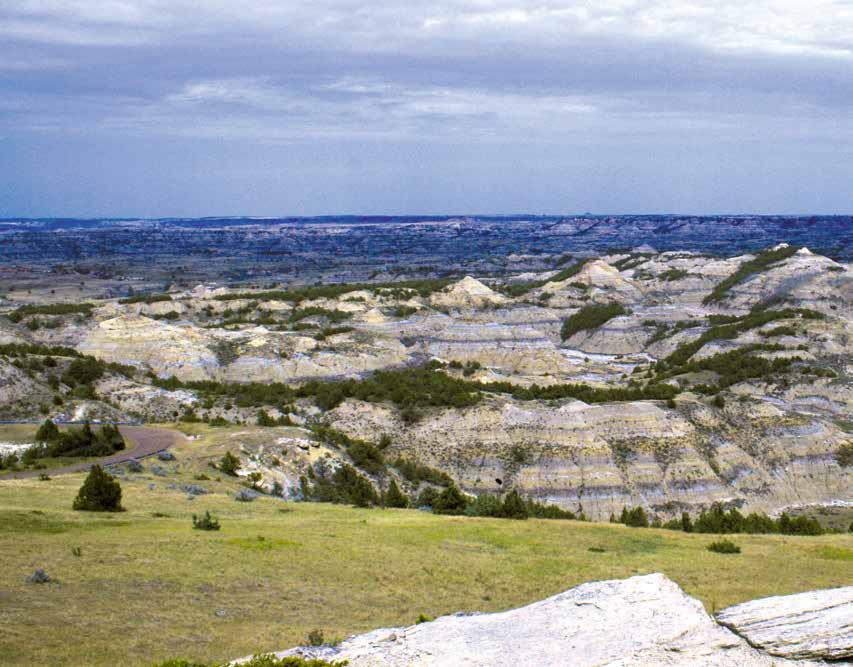
Where you stand depends upon where you sit, and what you see depends entirely on which lens you choose to wear. Spirit of place is mostly a lens we acquire because we want not just to occupy land but to inhabit it. Robert Frost had it right at JFK’s Inaugural:
Anglo-Americans are not good at surrender. American Indians, on the other hand, were experts at surrender, and until we learn to surrender a little to their cultural style, we probably cannot really come to terms with the spirit of place of the Great Plains.
If North Dakota has a spirit of place, some or all of the following elements must play a role: Open space with some sort of statistical minimum of human infrastructure appliquéd on it. A landscape vast and treeless rolling out to the vanishing point in every direction. Wind—breeze and blast, zephyr and shrieking madcap appalling wind-sweep, to ruin your picnic and shatter your family reunion. Flat or gently rolling country suddenly giving way, without warning, to broken country, coulees, badlands, jumble. Giants of the Earth skies in which humans are reduced to ant-like proportions against impossibly large backdrops in which the land is huge but the sky is huger. Buttes rising out of the land like shoebox reminders of the level of the land a million years ago, grassy remnants plopped down in the middle of nowhere, which the combined erosive forces of wind and water somehow left behind when they swept everything else into the Gulf of Mexico. The never far from the surface understanding that a very different people lived here and not very long ago, a people who wore very different lenses from ours, whose civilization we did everything in our power to sweep away, but whose spiritual signature on the landscape we still see and feel, and whose lingering presence challenges us right to the core from time to time even now. A sense of the temporariness of human habitations, a kind of joyfully anxious feeling that the wind might just sweep all that we have built away if we don’t keep battening it down. A respect for the unbelievably hard lives of the pioneers who proved up here a hundred plus years ago, laying down crops and crude shelters against the sub-Arctic cold in the most improbable landscape of America, whose lives are more authentically captured by Rachel Calof than by Laura Ingalls Wilder. The sense that there is nothing whatsoever standing between you and God, the Great Spirit, the Manitou, Allah, or the moons of Jupiter, and that there is no one to wrestle with the Angel of Death but you. An awareness of how few people can or want to live here, and how strange it is to choose to live away from the clusters of population and comfort of amenities when, in fact, you could choose to live anywhere. Storms: thunderstorms, windstorms, snowstorms, hailstorms, blizzards. A constant looking to the sky for trouble and for answers.
Not everyone will see spirit of place in North Dakota in quite this way. There are cultural elements, too, such as white wooden Lutheran churches out in the middle of nowhere with their steeples pointing up into the middle of nowhere, bars and hot dishes and white cakes in aluminum pans, brilliantly red and brilliantly green combines inching their way through wheat fields, sunflowers lined up in perfect Nuremburg rectilinearity as far as the eye can see. Fleischkeuchle in one café, borscht in another.
I want to draw a distinction between two types of North Dakotans (or Montanans, Oregonians, etc.). This distinction begins with the understanding that everyone lives somewhere. Everyone is from somewhere. If you grow a young person in North Dakota and then transplant her to, say, Seattle or Denver, in what ways does she remain a distinctive North Dakotan? She may like to identify herself as a North Dakotan. She may feel deep loyalty to North Dakota. She may be able to talk about the Medora Musical or Theodore Roosevelt National Park, about the state fair or vacations on Lake Sakakawea, but in what meaningful sense is she a North Dakotan? How—on any given day—is she different, if at all, from someone who was grown in Iowa or Florida or New Jersey? What is the North Dakota in a North Dakotan? In what way, if any, does the landscape of North Dakota shape the character of its young people?
I have found in my studies of spirit of place that there are two types of North Dakotan: accidental North Dakotans and naturalized North Dakotans. In the era of Best Buy and seasonal premium sports packages on cable or satellite television, most of us are accidental North Dakotans most of the time. By accidental I mean that we live here, on the near rectangle of North Dakota with its 70,762 thousand square miles, 45,287,680 acres of land, but at any given moment on any given day we are doing something that has nothing to do with place, something we could be doing anywhere or nowhere. At any given moment we dwell in what I’m calling mediated space. Whenever we eat and shop, work and watch LCD screens, we are not out listening to the wind in the grass. Many North Dakotans spend very little time outside. Some North Dakotans wish they lived somewhere else, particularly young people. Most North Dakotans are happy enough to be North Dakotans, maybe even proud to be North Dakotans, but there is nothing beyond a kind of habitual state patriotism and some relatively shallow cultural matter to buttress that pride. In other words, they would have the same pride for another state if they happened to be from that state. Nor is there anything wrong with that.
Many North Dakotans like living where there is no heavy traffic, no commute, no urban labyrinth to negotiate; where life is relatively simple and straightforward; where the population is ethnically unproblematic; where the farther reaches of lifestyle choice do not trouble the general homogeneity of the population. In other words, many North Dakotans like living in North Dakota principally because that is the world they know, and the world beyond their borders sounds discomforting or menacing or just unfamiliar. They might just as well be living somewhere else, but they find no sufficient reason to reject North Dakota, and no compelling reason to choose another place instead.
The snowbird phenomenon—in which tens of thousand flee after Halloween for Phoenix or Hemet--makes perfect sense, because North Dakota has brutal long winters, and people with money, like the geese, often prefer to seek a more temperate climate during the severest quarter of the year. But love of a place, like the love of a woman or a man, requires a holism to be fully authentic. If you love North Dakota only when the winds are still, the grass is lush, the sun is shining, and the temperature is above 70 degrees, it may be that you do not love North Dakota, but rather the California in North Dakota. On any given day in North Dakota, the wind is blowing. On any given day, it may be uncomfortable to be outside. On any given day, a storm may blow through when you least expect it. On any given day, you venture outside only with protective gear that would seem NASA-like to a Hawaiian.
North Dakotans who make the best of it, and like this place well enough, but would be equally happy in any number of other places, who spend a minimal or at best modest amount of time out in untrammeled nature, may be said to be accidental North Dakotans. My father was such a person. It was if, in a sense, he was stationed by a higher power in North Dakota, but if he had ever been given the chance to choose his home place, it would have been somewhere else—bustling Minnesota, at the very least. I believe that most North Dakotans are, as it were, stationed in North Dakota. Nor is there anything wrong with this, for people are also stationed in Missouri and stationed in New Mexico and stationed in Delaware. That is the standard paradigm of life in America in the 21st century. In the digital age, place is a platform rather than a home.
Naturalized North Dakotans are those who have decided to wrestle with the angel of North Dakota and find a way to accept it in all of its moods, and approve it too; to learn from it, to learn how to live in it, to learn how to be North Dakotans rather than Coloradans or Ohioans. Naturalized North Dakotans know the history of the state, the themes of the historical markers that dot the state’s highways. They know where the trails (the Totten Trail, the Bismarck to Deadwood Trail, the Lewis and Clark Trail, the Thieves road) threaded their way across the plains landscape. They know something about the way in which Anglos, Germans, Germans from Russia, Bohemians, Finns, Norwegians, Swedes and Lebanese penetrated west from the Great Lakes and the Red River in the course of the Homestead migrations, and where the cultural epicenter of those pioneer ethnic groups now resides. They know something about cultural footprints: the cultural footprint of the Mandan, Hidatsa, Arikara, Assiniboine, Lakota, Dakota, Ojibwe on today’s North Dakota, the cultural footprint of Abraham Lincoln, the two Roosevelts, Thomas Jefferson, George Armstrong Custer, de Mores and de Trobriand. They know such sacred places as Writing Rock (near Crosby), the Medicine Rock (near Leith), and the Medicine Hole (near Killdeer). They know more or less where the last buffalo hunt occurred in North Dakota in 1883 and they have stood on the hill where Karl Bodmer painted his famous watercolor of Fort Union at the confluence of the Yellowstone and the Missouri Rivers. They know where Sitting Bull surrendered on July 19, 1881, and where he was assassinated on December 15, 1890 in the tragic run-up to the Massacre at Wounded Knee.

More importantly, they know where they feel most alive, where they go to refresh their spirits, where they take significant others and special guests to see what North Dakota really is what it really means.
Hunting is still very important to the adult population of North Dakota, and hunters are very often naturalized, not accidental, North Dakotans. Each fall they take the time to get out on the land, in good weather or bad, and though they are ostensibly in quest of a deer or a duck or a pheasant, it is clear that they are more essentially in quest of a living connection with the landscape of the northern Great Plains. In fact, hunting is now the most significant spirit of place ritual of the North Dakota people. If hunting ceased to be a serious avocation, our slender hold on the soul of the Great Plains might blink out altogether, for the number of hikers, campers, cross country skiers, and wilderness sojourners is negligible compared with the hunting population. Critics of hunting are, for that reason more than any other, fundamentally misguided.
Eric Sevareid famously said that North Dakota was a blank spot at the center of the North American continent. North Dakotans tend to resent Sevareid’s characterization—merely because it is critical, because it hurts our pride—but it would be interesting to hear their defense of North Dakota culture.
Montana has a richer state literature than North Dakota. Think of James Welch, Annick Smith, Bill Kittredge, cowboy poet Paul Zarzyski, Ivan Doig, Rick Bass, Daniel Kemmis, Thomas McGuane, Stephenie Ambrose Tubbs. . . . Minnesota has a richer state literature than North Dakota. Even South Dakota has a richer state literature than North Dakota: Elizabeth Cook-Lynn, Paul Goble, Linda Hasselstrom, Frederick Manfred, Kathleen Norris, Dan O’Brien, Sally Roesch Wagner. Why should this be? To be sure, North Dakota has produced great writers. Larry Woiwode’s Beyond the Bedroom Wall is arguably the greatest novel by a living North Dakotan, and Louise Erdrich’s many novels, beginning with Love Medicine, are major North Dakota literature, if you wish to confine them to that category. There are other serious writers in North Dakota, too; I do not in any way mean to diminish their achievement. But the point is undeniable, that North Dakota is surrounded by states with a richer state culture than we have.
Why should this be so?
From a spirit of place perspective, North Dakota suffers from the “in between” problem. Montana has a distinct identity and personality. Minnesota has a distinct identity and personality. South Dakota is very much like North Dakota, but it has edgier Indians with a harder, more dramatic history, and it has the Black Hills, which are to the badlands of North Dakota what the badlands of North Dakota are to, say, the Killdeer Mountains. Saskatchewan and Manitoba don’t count, because the 310 mile border, though invisible from space, may as well be a mile high and equally thick.
North Dakota is not Midwestern like Minnesota, Iowa, Wisconsin, and Michigan. Nor is it western like Montana and Wyoming. I think it is undeniable that Fargo and Grand Forks identify themselves with the Midwest rather than with the Great Plains. In fact, many people of the Red River Valley regard North Dakota west of, say, Casselton, Cooperstown, and Carrington, much the way the famous New Yorker cartoon portrays America west of the Hudson River. Many citizens of Fargo and Grand Forks are a little embarrassed about North Dakota. Fully a third of the North Dakota population lives east of Interstate-29, which hugs the Minnesota border. This creates a double problem for North Dakota’s spirit of place. Not only is the population congealed on the Minnesota border, leaning east not west, but it is undeniable that the cultural centers of North Dakota are in Fargo and Grand Forks, where the idea of North Dakota matters less than it does in Williston, Dickinson, Grassy Butte, Wishek, or even Bismarck or Minot. If the majority of the thinkers, philosophers, poets, sculptors, painters, musicians, novelists, etc., live in the part of the state that essentially identifies itself with Minnesota (which it is not), rather than North Dakota (which technically, at least, it is), it cannot be expected that that significant group of cultural leaders are going to do much to help clarify and define North Dakota. Their souls are rooted elsewhere. They are certainly not rooted in Grassy Butte or Mott. They should not be blamed for their detachment from North Dakota. They are, of course, free to pursue their cultural projects in any way that satisfies them. But it does not do North Dakota spirit of place much good.
Cultural achievement can occur in scattered places, in the music of Chuck Suchy (Mandan) or the ceramic art of Tama Smith (Beach) or Robin Reynolds (Hebron), but historically it has tended to flourish where there is a critical mass of population and prosperity. The Renaissance requires Florence and the Elizabethan miracle requires London. The Parthenon gets built in Athens not Ithaka, and the Guggenheim winds up in New York not New Leipzig. The only zone in North Dakota where there is any real expectation of a cultural effervescence of the kind that could create a distinctive North Dakota culture is the university and population barbell of Fargo—Grand Forks. And that is the part of North Dakota that is least interested in the North Dakota project. This is a paradox as old as North Dakota history. In spite of the flat world revolution of the Internet, it grows more pronounced every year, whether we like to admit it or not.
So add up the following factors: One—the primary cultural population is edgy about North Dakota and it leans into Minnesota. Two--the cultural exemplars in the rest of the state are so diffused geographically, so isolated, that they do not get sufficient nurturing and cross-fertilization to take on the challenge of creating an authentic North Dakota culture and they live in communities that are not fully supportive of the eccentricities of artists and the challenges of art and literature. Three—North Dakota suffers from a fundamental identity problem (in betweenness) that has had a paralytic effect on its attempt (or even its willingness) to create a distinctive culture. Four—we live in a time when Americans are more culturally homogenized and our common experiences are more mediated than at any previous moment in our history. Five—North Dakotan spend less time out of hermetically sealed environments than ever before in their history.
The result is a dearth of serious North Dakota art and literature, in which the remarkable exceptions prove the rule; a weak sense of North Dakota identity in old people and young; a sense that there is nothing here worth preserving, fighting for, staying to protect and enlarge; a daily affirmation of Sevareid’s thesis, at the same time we rage against so unfair a characterization of our cultural project; a turn toward the deracinated national homogenous culture that pays attention to North Dakota only to ridicule it; the stifling of the creative impulse in the young people who stay; disillusionment; and outmigration, not to mention the most server teenage binge drinking problem in the nation.
Here, more than in all other places, we need to cultivate spirit of place.
So if my analysis is true, what’s the remedy?
1. We need to create a much more serious North Dakota studies curriculum in our schools. Geography, Native American studies, the varieties of prairie spirituality, and Great Plains literature need to be at the core of that new curriculum.
2. We need far more school field trips—not necessarily to museums and large auditorium presentations, but just out into the middle of nowhere, to the buttes, ridges, coulees, trade and military forts, lonely monuments to David Thompson, and above all to the Indian reservations.
3. We need to use some of our immense energy wealth, our huge and growing budget surplus, to seed young sculptors, painters, essayists, novelists, poets, etc. and NOT in our cultural capitals, which have reached a self-sustaining level of cultural activity.
4. We need to create several new Centers of Excellence in North Dakota studies, to provide them with the same sorts of start-up funds we have provided for the business entrepreneurial Centers of Excellence.
5. We need to create a range of all-expenses scholarships for young intellectuals who wish to do graduate work in North Dakota, Great Plains, and Upper Missouri studies, and provide special incentives for them to stay in North Dakota for at least a significant period of time following their academic labors.
6. North Dakotans need to write about their experiences, their family stories, their memories, their sense of the history, the identity, and the landscape of North Dakota, their vision of the future and their understanding of what is possible in North Dakota. North Dakotans of all political views, backgrounds, levels of education, professions, and general outlooks.
7. Above all, all of us need to get out into the open nature of North Dakota, to listen to the wind, to walk along the ridges, to have picnics in the middle of nowhere, to visit all the state parks and historical sites of North Dakota, to walk endlessly, to lie on our backs at night looking up at the stars and listening to the coyotes and waiting patiently for the Northern Lights.
Will this make the difference? The answer is almost certainly yes. Anything else is the politics of indifference and decline. In my opinion nothing would be more likely to keep young people in North Dakota than to create a new sense of our identity, a new pride in what North Dakota means—geographically, culturally, historically, ideologically. Such an enterprise represents a doable and inexpensive investment in our future.
We have nothing to lose but our chain-stores.
Clay S. Jenkinson’s book Message on the Wind: A Spiritual Odyssey on the Northern Plains maps out his quest to find spirit of place in this empty northern hemisphere.

